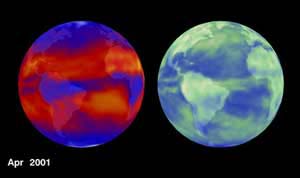Studies Raise Questions about Climate Change

Image: Courtesy of NASA
Climate prediction just got trickier, according to two new studies appearing in the current issue of the journal Science. Analysis of more than two decades of satellite data shows that more sunlight entered the tropics and more heat escaped to space in the 1990s than a decade earlier. Moreover, current climate models fail to account for the new findings, suggesting that they may contain more uncertainty than previously thought.
For the earth’s climate to remain unchanged, the planet’s energy budget must equal zero—that is, the planet must emit or reflect the same amount of energy that enters as sunlight. But that’s not what Columbia University researcher Junye Chen and colleagues found when they studied thermal radiation emitted by earth (left sphere in image) and reflected sunlight (right sphere in image) over the tropics. Between 1985 and 2000, they found, the amount of energy emitted increased while the amount reflected decreased, with most of the change occurring after 1990. The findings suggest that the movement of air masses over the tropics—the so-called Hadley and Walker circulation cells—increased in strength, causing rising air to become moister and sinking air drier.
In the second study, Bruce Wielicki of NASA’s Langley Research Center and colleagues demonstrated that the earth’s radiative energy budget varies on timescales as short as a decade, making it much more variable than previously thought. Using satellite data covering 22 years, they identified peaks in the amount of energy escaping the atmosphere and seasonal variations in the amount of incoming radiation. “We tracked the changes to a decrease in tropical cloudiness that allowed more sunlight to reach the earth’s surface,” Wielicki explains. “But what we want to know is why the clouds would change.” Failure to fully account for the effects of clouds is one of the greatest weaknesses of current climate models. Indeed, four major climate models could not reproduce the tropical cloud changes or generate what the researchers call the “more subtle, but still large, decadal changes seen in the radiation data.”
The scientists do not yet know what causes this variation in tropical radiation. “We think this is a natural fluctuation,” Anthony Del Genio of NASA’s Goddard Institute for Space Studies says, “but there is no way to tell yet.” Still, he advises, even before knowing the cause of the variability, researchers should attempt to modify their models in order to accommodate it.
Media Contact
All latest news from the category: Earth Sciences
Earth Sciences (also referred to as Geosciences), which deals with basic issues surrounding our planet, plays a vital role in the area of energy and raw materials supply.
Earth Sciences comprises subjects such as geology, geography, geological informatics, paleontology, mineralogy, petrography, crystallography, geophysics, geodesy, glaciology, cartography, photogrammetry, meteorology and seismology, early-warning systems, earthquake research and polar research.
Newest articles

NASA: Mystery of life’s handedness deepens
The mystery of why life uses molecules with specific orientations has deepened with a NASA-funded discovery that RNA — a key molecule thought to have potentially held the instructions for…

What are the effects of historic lithium mining on water quality?
Study reveals low levels of common contaminants but high levels of other elements in waters associated with an abandoned lithium mine. Lithium ore and mining waste from a historic lithium…

Quantum-inspired design boosts efficiency of heat-to-electricity conversion
Rice engineers take unconventional route to improving thermophotovoltaic systems. Researchers at Rice University have found a new way to improve a key element of thermophotovoltaic (TPV) systems, which convert heat…



